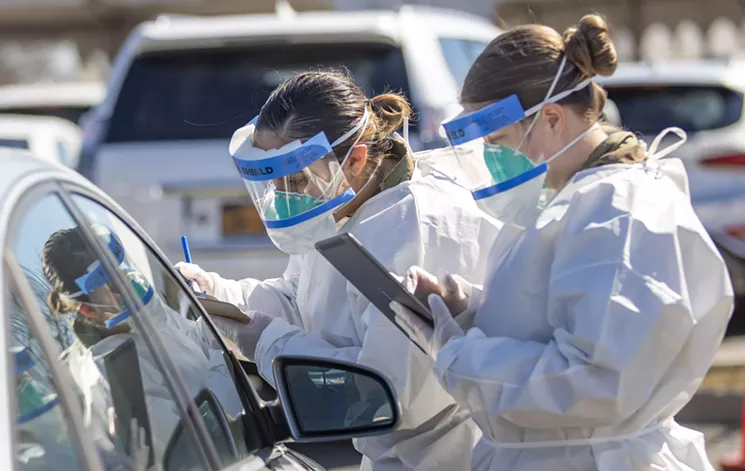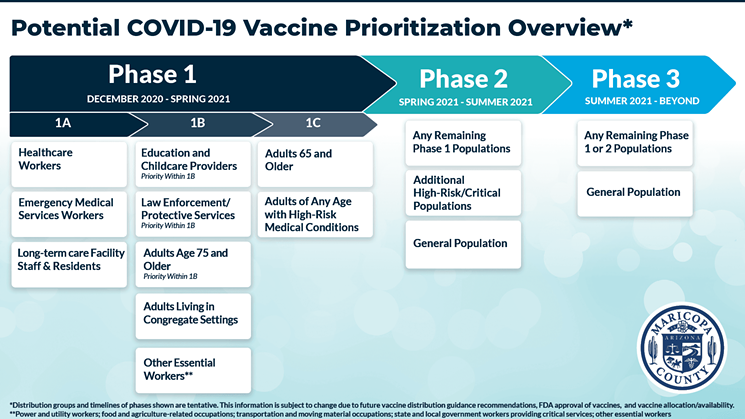Arizona is averaging 6,700 cases of COVID-19 each day. The number of new cases each day is still decreasing slightly, but not as quickly as last week. Experts describe the situation as more of a plateau than a sustained decrease. The number of people being infected with COVID-19 still remains much worse than over the summer. An average of 3,844 people were infected each day at the peak of that surge.
Arizona led the country for the number of COVID-19 cases by population in the last week. The state averaged 95.6 cases per 100,000 people in the last seven days, according to Centers for Disease Control and Prevention data. The next worst state, South Carolina, averaged 83.6 cases per 100,000 people. Oregon did the best in the continental United States, with an average of 16.8 cases per 100,000 people.
The number of people hospitalized for COVID-19 is also decreasing slightly. The number of intensive-care beds in use statewide had dropped slowly in recent days. Currently, 57 percent of beds are in use by COVID-19 patients. Overall, the number of patients is still higher than over the summer and less than 10 percent of overall intensive-care beds remain available. The number of intubations is also down, but more than 100 people still have tubes inserted down their throat as a last-ditch effort every day.
Hospitals are still highly stressed. Banner Health Chief Clinical Officer Marjorie Bessel told the media last Wednesday that hospitalizations are still 700 percent higher than they were on November 1, and that ventilator usage is up 1,000 percent since then. She said that the hospital chain, the state's largest, does not expect to reach pre-surge levels for another 10 to 11 weeks.
Banner continues to use refrigerated trucks to store bodies that won't fit in its morgue. In addition, Banner is storing bodies from outside of non-Banner hospitals. Of those, 58 percent are COVID-19 patients.
In a rare bit of good news, Bessel said that as of Monday, some hospitals would be able to resume outpatient surgeries. Hospitals had delayed "elective" surgeries, (defined as those that don't lead to immediate death if delayed), due to being overburdened. The move is still very partial. It's on a hospital-to-hospital basis and doesn't include surgeries that require intensive-care recovery.
The lower number of positive cases may be driven by a lack of people getting tested for COVID-19. "I'm a little concerned this is not real," Arizona State University Biodesign Institute executive director Joshua LaBaer said of the drop in case numbers last Wednesday. Currently, 34 percent of tests for COVID-19 statewide are coming back positive on average, with some days seeing as many as half of all tests turn up positive. LaBaer said that number should be closer to 5 percent. He wants to see as many as four to eight times as many people get tested and attributed the lack of people seeking out testing to fatigue. "We certainly have way more capacity than is being used now," LaBaer said.
LaBaer recommends that people who regularly interact with the public get tested once a week. You can find a list of testing locations here. ASU also offers free, quick-turnaround saliva testing here.

Members of the New York National Guard register people at a COVID-19 mobile testing center in New Rochelle, New York on March 14.
It's been one year since the first case of COVID-19 in Arizona. On January 26, 2020, it was announced that a member of the ASU community had been diagnosed with the disease after returning from Wuhan, China. For a while, Phoenix New Times tried to keep track of every case reported in the state before giving up due to the rapidly increasing number. The state's first death came in March — a Phoenix airport worker in his 50s. Since then, 12,448 Arizonans have lost their lives as the result of a COVID-19 infection. This means that COVID-19 has surpassed heart disease as the leading cause of death in Arizona.
Asked about the upcoming anniversary last Friday, Arizona Department of Health Services Director Dr. Cara Christ said that it been a long year. If she had done something differently, it would have been to encourage public health workers to take breaks and take care of themselves, she said.
"We've been fortunate here in Arizona because a lot of our public health systems are still intact and still have the phenomenal leadership that our local levels have had," she said. "And I think that's an important thing because a lot of states have not had that."
Looking forward, she wants people to continue following mitigation strategies, get vaccinated, and accept that we may be returning to a "new normal."
It turns out that the uncontrolled spread of COVID-19 may be bad for the economy. The Cactus League has asked to delay spring training, citing Maricopa County's infection rate — one of the highest in the nation. Meanwhile, the Arizona Interscholastic Association has decided to resume high school sports. Bessel at Banner called indoor sporting events in enclosed spaces where students are coming in close contact with each other "a prime scenario by which the virus loves to spread."
Local venue The Pressroom has been shut down by the state for violating COVID-19 protocols. The move comes after the Arizona Republic reported that it had hosted a concert with more than 100 people packed in close quarters two weeks ago. Enforcement of COVID-19 mitigation measures has been a contentious subject, with Arizona Public Health Association head Will Humble blasting the state for falling short and Christ putting the blame on local authorities.
As of Monday, 458,461 doses of COVID-19 vaccines had been administered in Arizona. In total, a little less than 70,000 people have received the two doses of the vaccine needed to receive the brunt of the protective effects that come with it.
ASU contact tracers have encountered clusters of people who got one dose of the vaccine, but who then became infected after they decided to gather with others in disregard of COVID-19 precautions. Even after receiving a second dose of a vaccine, it still takes several weeks for it to take full effect, experts say. Even then, clinical trials have shown that the vaccine does not provide complete protection against COVID-19 for a small percentage of people. Experts recommend continuing with all the same precautions after receiving the vaccine as before, both to protect yourself and because it is unknown if the vaccine prevents transmission to others. Only when enough people are vaccinated to reach herd immunity can we let our guard down. "Even though the vaccine has hit thousands of arms already, the number of vaccines that have gone out have no appreciable impact on the spread of the virus," LaBaer at ASU said.
Not controlling COVID-19's spread may make it harder to reach herd immunity. As the virus infects more people, the odds of more variants emerging increase, LaBaer said. More infectious variants, like the U.K. one spotted in Colorado, mean more people will need to be vaccinated to reach herd immunity, he added. Other variants, like one recently discovered in South Africa, may be more resistant to the vaccine. One way to protect against more infectious variants besides continuing to avoid gatherings outside your household? Doubling up on masks.
That state continues to tweak its vaccination registration system, but people are still confused. The Arizona Department of Health Services tweeted out instructions about how to book a second dose of the vaccine at state-run sites Monday and the comments quickly filled with people unable to figure out how to sign up. Despite the confusion, second dose appointments are currently filled through February 17. Here's an account of what it was like to get vaccinated at State Farm Stadium.

Maricopa County is currently in the prioritized phase of 1B. This chart isn't totally accurate as the county is currently prioritizing only K-12 and childcare providers. The state is following similar guidelines but including people 65 and older.
Maricopa County












